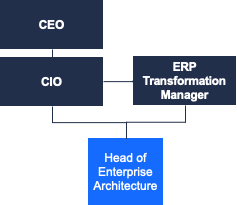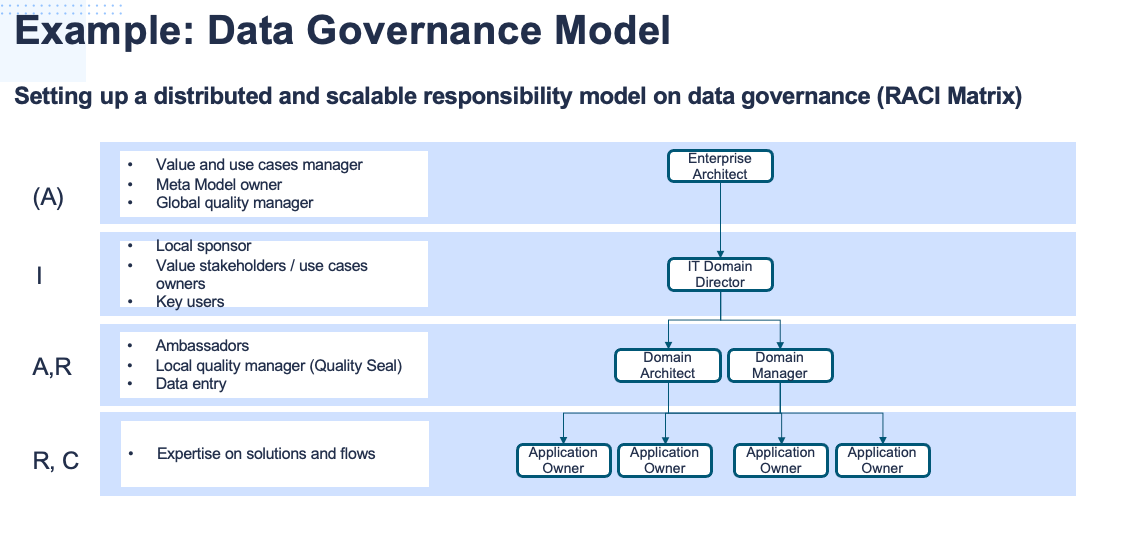Phase 0. Foundation: Transformation Strategy and Setup
Define goals and strategy for transformation, laying the foundation for well-informed migration decisions and budget planning. Clearly outline the role of Enterprise Architect in the process.
Overview
Before an ERP transformation is initiated with the discovery phase, there is a preliminary “Phase zero.” This phase concludes with a formal decision to start the migration and plan respective budgets. The artifacts produced during this phase include:
- A discussion and documentation of the transformation's goals and its business case (e.g., high-level benefits vs. costs).
- A decision or at least a strong hypothesis on the transformation approach (typically, three different approaches are discussed: Greenfield-, Brownfield, or Hybrid Approach).
- The setup of the transformation program to be initiated, e.g., program organization, involvement of external consultants, identification of business units to be involved, etc.
It is important to understand that during this phase - even though the details will only be worked out in subsequent phases - a lot of information on the current solution, the benefits of moving to a new ERP solution, the capabilities of the organization, details about data and interface availability, etc. is required for informed discussions and sound decision-making. Typically, Integration Architecture is a key aspect of identifying the right migration approach.
Often, external consultants are involved in this phase. While they might have a good external perspective, they might lack knowledge of your specific situation. As an Enterprise Architect, you should ensure that you are involved and contribute in this phase and make aware of the critical role of EA and a good transparency of the as-is architecture for a successful Day-1 without any bad surprises. To make one example: Imagine that your organization decides to change the length of the personal ID number in the HR system from 5 to 8. You need to know exactly which systems are connected and need to be adjusted - otherwise, data flow and processes might be blocked, which can have serious consequences (e.g., payroll).
Ideally, your organization can use LeanIX already in this phase for a good pre-study and informed decision-making. At least, you as an EA should ensure the active participation of the Enterprise Architect team by clearly defining its role in the ERP transformation.
The Contribution of Enterprise Architects to Phase 0
Looking at the questions typically addressed during this phase, Enterprise Architects can contribute in many ways, e.g.,
- Create transparency on the current landscape and well-known transformation needs due to, e.g., technological changes, technical debt, missing functional fit, etc.
- Share your view on (run) costs associated with platforms, applications, or IT components in scope.
- Discuss the potential architectural impacts of the different transformation approaches.
- Understand the impact on existing transformations and the effect on their roadmaps.
Much of the data needed to contribute to these discussions could be extracted from your LeanIX solution. If any data is missing, the impending ERP transformation can provide a strong lever to escalate LeanIX adoption.
Define the Role of EA for the Subsequent Phases of the ERP Transformation
Beyond contributing to the discussions in this phase, you should establish clarity regarding who is involved in the ERP transformation, which roles and responsibilities the EA Practices versus other stakeholders, and the collaboration model.
For instance, it's common for an ERP Transformation or Program Manager to be responsible for the entire program. This person typically reports to the CIO (and other C-level positions). The Head of Enterprise Architecture reports to the Transformation Manager as part of the Program but also has a reporting line to the CIO in their wider EA role.

Typical reporting structure in ERP transformation
The roles, processes, and tasks of the stakeholders are typically determined by the overall ERP transformation program. The task of the leading EA is to establish a solid foundation for the effective usage of LeanIX by setting up a governance process.
Aligning with key stakeholders on the following topics can facilitate achieving this goal:
- What insights are needed for each stakeholder? What decisions do you/they intend to secure?
- What data is required from which stakeholders at what point in time?
- What process should they follow to provide that data? Often, a Program Management Office (PMO) is involved in gathering information from various sources - what is the interface between the PMO and the EA?
- In what cadence should insights be shared? When is alignment needed?
- How can you harness the EA community in your organization to support the transformation?
The outcome of this step should be the following assets:
- Clearly defined picture of the stakeholder (EA and departments) ecosystem.
- Data governance model with distributed responsibilities.
- Reference materials showing how LeanIX is positioned in the ecosystem alongside other tools (e.g., Signavio, ServiceNow, JIRA, Confluence), where integrations can be beneficial for data leverage/synchronization.

Data governance model example
Updated 3 months ago
